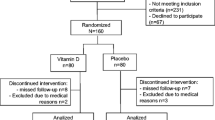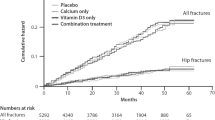Abstract
Summary
This study reports on oral treatment with different doses of vitamin D3 ranging from 25 to 200 µg in females with 25-hydroxyvitamin D3 levels < 60 nmol/L screened for participation in an osteoporosis trial. A guidance to safely and efficiently achieve 25-hydroxyvitamin D3 levels > 60 nmol/L is presented.
Introduction
The importance of vitamin D for skeletal health has been implemented in clinical trials in osteoporosis. The threshold of 25-hydroxyvitamin D for inclusion has changed from 30 to 60 nmol/L. This study reports on oral treatment with different doses of vitamin D3 in females with 25-hydroxyvitamin D3 levels < 60 nmol/L.
Methods
In 131 postmenopausal females screened for participation in an osteoporosis trial, the 25-hydroxyvitamin D3 concentration was < 60 nmol/L. They were treated with 25 (n = 22), 50 (n = 19), 75 (n = 19), 100 (n = 41) or 200 μg (n = 30) of vitamin D3 daily for at least 10 days.
Results
In the females treated with 25, 50, 75, 100 and 200 μg of vitamin D3 daily the 25-hydroxyvitamin D3 concentrations increased significantly from 32.4 ± 2.7 (mean ± SEM) to 50.8 ± 2.9, from 46.7 ± 2.8 to 65.8 ± 2.6, from 41.6 ± 2.7 to 67.4 ± 2.9, from 46.7 ± 1.4 to 64.4 ± 2.2 and from 42.1 ± 2.0 to 71.2 ± 2.8 nmol/L, respectively (p < 0.001). S-calcium increased significantly but within the reference range (p < 0.006).
Conclusion
Oral vitamin D3 safely increased 25-hydroxyvitamin D3 concentrations in all females above 60 nmol/L. This study demonstrates how to achieve the new recommended 25-hydroxyvitamin D concentrations within the screening period of a clinical trial.



Similar content being viewed by others
References
Zerwekh JE (2008) Blood biomarkers of vitamin D status. Am J Clin Nutr 87(4):1087S–1091S
Dawson-Hughes B, Heaney RP, Holick MF et al (2005) Estimates of optimal vitamin D status. Osteoporos Int 16(7):713–716
Hollis BW, Wagner CL (2005) Normal serum vitamin D levels. N Engl J Med 352(5):515–516
Chapuy MC, Preziosi P, Maamer M et al (1997) Prevalence of vitamin D insufficiency in an adult normal population. Osteoporos Int 7(5):439–443
Need AG, Horowitz M, Morris HA et al (2000) Vitamin D status: effects on parathyroid hormone and 1, 25-dihydroxyvitamin D in postmenopausal women. Am J Clin Nutr 71(6):1577–1581
Sahota O, Mundey MK, San P et al (2004) The relationship between vitamin D and parathyroid hormone: calcium homeostasis, bone turnover, and bone mineral density in postmenopausal women with established osteoporosis. Bone 35(1):312–319
Heaney RP (2005) The Vitamin D requirement in health and disease. J Steroid Biochem Mol Biol 97(1–2):13–19
Bischoff-Ferrari HA, Dietrich T, Orav EJ et al (2004) Positive association between 25-hydroxy vitamin D levels and bone mineral density: a population-based study of younger and older adults. Am J Med 116(9):634–639
Lips P, Duong T, Oleksik A et al (2001) A global study of vitamin D status and parathyroid function in postmenopausal women with osteoporosis: baseline data from the multiple outcomes of raloxifene evaluation clinical trial. J Clin Endocrinol Metab 86(3):1212–1221
Lappe JM, Davies KM, Travers-Gustafson D et al (2006) Vitamin D status in a rural postmenopausal female population. J Am Coll Nutr 25(5):395–402
Smith JE, Goodman DS (1971) The turnover and transport of vitamin D and of a polar metabolite with the properties of 25-hydroxycholecalciferol in human plasma. J Clin Invest 50(10):2159–2167
Vieth R, Chan PC, MacFarlane GD (2001) Efficacy and safety of vitamin D3 intake exceeding the lowest observed adverse effect level. Am J Clin Nutr 73(2):288–294
Heaney RP, Armas LA, Shary JR et al (2008) 25-Hydroxylation of vitamin D3: relation to circulating vitamin D3 under various input conditions. Am J Clin Nutr 87(6):1738–1742
Trang HM, Cole DE, Rubin LA et al (1998) Evidence that vitamin D3 increases serum 25-hydroxyvitamin D more efficiently than does vitamin D2. Am J Clin Nutr 68(4):854–858
Holick MF, Chen TC (2008) Vitamin D deficiency: a worldwide problem with health consequences. Am J Clin Nutr 87(4):1080S–1086S
Hollis BW (2005) Circulating 25-hydroxyvitamin D levels indicative of vitamin D sufficiency: implications for establishing a new effective dietary intake recommendation for vitamin D. J Nutr 135(2):317–322
Harris SS, Dawson-Hughes B (2002) Plasma vitamin D and 25OHD responses of young and old men to supplementation with vitamin D3. J Am Coll Nutr 21(4):357–362
Geller JL, Hu B, Reed S et al (2008) Increase in bone mass after correction of vitamin D insufficiency in bisphosphonate-treated patients. Endocr Pract 14(3):293–297
Heckman GA, Papaioannou A, Sebaldt RJ et al (2002) Effect of vitamin D on bone mineral density of elderly patients with osteoporosis responding poorly to bisphosphonates. BMC Musculoskelet Disord 3:6, doi:10.1186/1471-2474-3-6
Malabanan A, Veronikis IE, Holick MF (1998) Redefining vitamin D insufficiency. Lancet 351(9105):805–806
Lips P, Chapuy MC, Dawson-Hughes B et al (1999) An international comparison of serum 25-hydroxyvitamin D measurements. Osteoporos Int 9(5):394–397
Binkley N, Krueger D, Cowgill CS et al (2004) Assay variation confounds the diagnosis of hypovitaminosis D: a call for standardization. J Clin Endocrinol Metab 89(7):3152–3157
Holick MF, Siris ES, Binkley N et al (2005) Prevalence of Vitamin D inadequacy among postmenopausal North American women receiving osteoporosis therapy. J Clin Endocrinol Metab 90(6):3215–3224
Pepe J, Romagnoli E, Nofroni I et al (2005) Vitamin D status as the major factor determining the circulating levels of parathyroid hormone: a study in normal subjects. Osteoporos Int 16(7):805–812
Armas LA, Hollis BW, Heaney RP (2004) Vitamin D2 is much less effective than vitamin D3 in humans. J Clin Endocrinol Metab 89(11):5387–5391
Houghton LA, Vieth R (2006) The case against ergocalciferol (vitamin D2) as a vitamin supplement. Am J Clin Nutr 84(4):694–697
Holick MF, Biancuzzo RM, Chen TC et al (2008) Vitamin D2 is as effective as vitamin D3 in maintaining circulating concentrations of 25-hydroxyvitamin D. J Clin Endocrinol Metab 93(3):677–681
Gordon CM, Williams AL, Feldman HA et al (2008) Treatment of hypovitaminosis D in infants and toddlers. J Clin Endocrinol Metab 93(7):2716–2721
Hollis BW (2004) Editorial: the determination of circulating 25-hydroxyvitamin D: no easy task. J Clin Endocrinol Metab 89(7):3149–3151
Hypponen E, Power C (2007) Hypovitaminosis D in British adults at age 45 y: nationwide cohort study of dietary and lifestyle predictors. Am J Clin Nutr 85(3):860–868
Arunabh S, Pollack S, Yeh J et al (2003) Body fat content and 25-hydroxyvitamin D levels in healthy women. J Clin Endocrinol Metab 88(1):157–161
Prosser DE, Jones G (2004) Enzymes involved in the activation and inactivation of vitamin D. Trends Biochem Sci 29(12):664–673
Clemens TL, Zhou XY, Myles M et al (1986) Serum vitamin D2 and vitamin D3 metabolite concentrations and absorption of vitamin D2 in elderly subjects. J Clin Endocrinol Metab 63(3):656–660
Ernst B, Thurnheer M, Schmid SM, et al (2008) Seasonal Variation in the Deficiency of 25-Hydroxyvitamin D(3) in Mildly to Extremely Obese Subjects. Obes Surg doi:10.1007/s11695-008-9636-2
Acknowledgement
We are indebted to Mrs. Lene Ulrichsen for help in the collection of the data.
Conflicts of interest
Hans C. Hoeck: employed by CCBR (Center for Clinical & Basic research), a private research company engaged in contract research with various pharmaceutical and biotech companies. Bo Li and Per Qvist: employed by Nordic Bioscience, a privately owned biotech company based in Denmark and engaged in medical research.
Author information
Authors and Affiliations
Corresponding author
Rights and permissions
About this article
Cite this article
Hoeck, H.C., Li, B. & Qvist, P. Changes in 25-Hydroxyvitamin D3 to oral treatment with vitamin D3 in postmenopausal females with osteoporosis. Osteoporos Int 20, 1329–1335 (2009). https://doi.org/10.1007/s00198-008-0790-0
Received:
Accepted:
Published:
Issue Date:
DOI: https://doi.org/10.1007/s00198-008-0790-0




